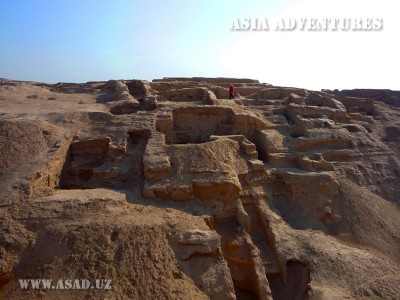
Kara-tepe is a 1st-4th-century Buddhist monastic complex built on three hills in the northwestern part of Termez. The complex includes a few temples and monasteries constructed in the early 2nd century AD.
Kara-tepe features original architecture, which consists of a combination of caves in sandstone and external structures built of pakhsa (rammed earth) and mud bricks. The internal parts of the temples were decorated with themed drawings, ornamental patterns on plaster and loess and clay sculptures. Marble-like limestone and fretted gypsum were widely used in the ornamentation of the temples.
The Buddhist complex flourished in the 2nd-3rd centuries. However, by the 4th-5th centuries most of its temples had stopped operating. In this period many of the caves were already used as graves, so their entrances were blocked with bricks. The walls of the Kara-tepe caves are still covered richly with ancient images and inscriptions in Old Bactrian, Persian, Sogdian, Syrian and Arab, which were made both when Buddhism was in its Zenith and when it was already declining.
Kara-tepe lies within the state border area, which means you have to apply for a special permit 40 days before the trip. Asia Adventures will help you do it.

 Centralasia Adventures
+998712544100
Centralasia Adventures
+998712544100





